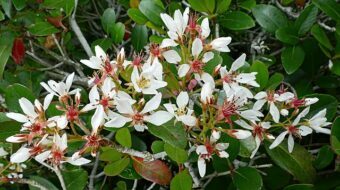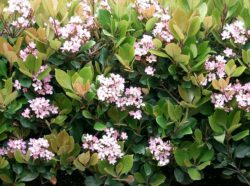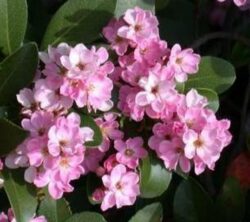In this article, we will discuss how to grow the unusual shrub of Rhaphiolepsis in containers. Rhaphiolepsis is a genus of 15 species of evergreen shrubs that belong to the Rosaceae (the Rose) family. It is native to warm regions and subtropics of East and Southern Asia, Japan, Korea, China, Thailand and Vietnam.

It is closely related to Eriobotrya, so close that the two genera have been hybridised to produce a hybrid Eriobotrya deflexa x Rhaphiolepsis indica, the Coppertone Loquat. The common name comes about due to its close relation to Crataegus, the Hawthorn, which has been transferred to some species of Rhaphiolepsis.
They often grow to 1.5m in size, whilst one species R. ferruginea can reach up to 10m high. The shrub tends to have alternative, leathery, dark green, glossy leaves that are simple or entire or serrate margin. In June, flowers of white, light pink, dark pink, or red are produced. They are large flowers, up to 2cm in diameter and are produced in small to large corymbium-like panicle structures. The flowers are often pleasantly scented and are followed by small, apple-like fruits that are 2cm in diameter and contain a single seed that is dark purple to black.
The main disadvantage of Rhaphiolepsis is that they are not fully hardy and shrubs can be killed in abnormally severe winters. Find out how to grow Rhaphiolepsis in containers in this article.
GROWING RHAPHIOLEPSIS ON CONTAINERS

The good news is that they tend to be easy to grow. First, you will need to choose a large container that has enough drainage holes at the bottom. To this, add a 2cm layer of gravel to aid drainage even further. On top of this add multipurpose compost to within 5cm of the top rim of the container.
Dig a hole at the centre of the container slightly bigger than the root ball it came in the original pot you bought it in. Place the plant in so that the top of the root ball is at the same level as the top surface of the compost in the container. Backfill with the growing media and compact it around the roots so no gaps remain, using more compost if necessary. Firm the plant in and water very well.
THE BEST GROWING CONDITIONS
You will need to place your container in a sheltered, south-facing location in full sun or partial shade. This is important as said earlier the shrub is not totally hardy and it will need some protection from the cold winds and harsh frosts.
It has a slow-growing habit and will take many years to reach its natural height of 1.5m.
It must be kept moist at all times, so as soon as the top surface of the compost feels dry to the touch, it is time to water. Water until it emerges from the drainage holes. Try to keep the compost as evenly moist as possible.
Fertilization is very important so in early spring give an annual dressing of general-purpose, slow-release, fertilizer. You will not need to feed anymore during the growing season.
Pruning is not necessary but you can remove unwanted or damaged branches in early spring.
To propagate, you will need to take semi-ripe cuttings in late summer and place them in a cold frame. An alternative is to layer stems in autumn for planting next year.
PESTS AND DISEASES
The good news is that the plant does not suffer from any known pests or diseases. The only problem you are likely to face is that very severe frosts can kill the shrub. To avoid this, you will need to place the container in an area that is south-facing and against a wall and your plant should survive.
VARIETIES TO GROW

The main species is Rhaphiolepsis umbellata where white flowers appear in early summer and are followed by near black-berries.
The other species you can find is Rhaphiolepsis x delacourii which is a taller plant, growing 2m high over time, especially against a sunny, south-facing wall. It is also tenderer as it produces its upright pink flower heads. For a light shade of pink grow ‘Spring Song’ and for a darker red shade choose ’Coates Crimson’
A final species to consider is Rhaphiolepsis indicia ‘Spring Time’ which produces Pink Apple-blossom flowers. It will grow up to 2m in height.
CONCLUSIONS
In this article, we have discussed how to grow the unusual shrub of Rhaphiolepsis in containers. They are such delightful shrubs which produce scented, elegant pink or white flowers, they are easy to care for, easy to look after, suffer from little in the way of pests and diseases, and you have a choice to what species or variety you can grow,
A beauty that is worth growing in the container garden. If you have any questions or comments that you wish to make on growing Rhaphiolepsis in containers, please do so in the comment box below.
Happy Rhaphiolepsis growing.
